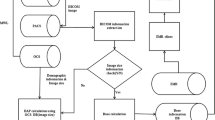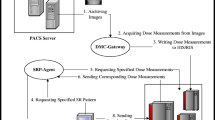Abstract
On X-ray modalities, the information concerning the dose delivered to the patient is usually available in image headers or in structured reports stored in the picture archiving and communication system (PACS). Sometimes this information is sent in the Modality Performed Procedure Step message. By saving the information inside the Radiological Information System, it can be linked to the patient and to his/her episode/request. A software, “Gray Detector,” implementing different and complementary extraction methods was developed. Query/retrieve on images header, Modality Performed Procedure Step message analysis, or the combination of the two methods were used. In order to avoid erroneous dose-protocol association, every accession number is linked to its unique report code, allowing multiple-protocols exam recognition. The adoption of different methods to extract dosimetric information makes it possible to integrate any kind of modality in a vendor/version neutral way. Linking the dosimetric information received from a modality to the patient and to the unique report code solves, for example, common problems in computed tomography exams, where the dosimetric value related to multiple segments/studies on the modality can be associated by the technician who performs the exam only to one accession number corresponding to a single study/segment. Analyses of dosimetric indexes’ dependence on modality type, patient age, technician, and radiologist were performed. Linking dosimetric information to radiological information system data allows a contextualization of the former and helps to optimize the image-quality/dose ratio, thereby making it possible to take a clinical decision that is “patient-centered.”








Similar content being viewed by others
References
Tsalafoutas IA, Thalassinou S, Efstathopoulos EP: A Comprehensive Method for Calculating Patient Effective Dose and Other Dosimetric Quantities From CT DICOM Images. Am J Roentgenol 199:133–141, 2012
Cook TS, Zimmerman SL, Steingall SR, Maidment AD, Kim W, Boonn WW: RADIANCE: An automated, enterprise-wide solution for archiving and reporting CT radiation dose estimates. Radiographics 31(7):1833–1846, 2011
David G, Redden AE: Retrospective analysis of computed radiography exposure reporting. Radiol Technol 83(1):29–35, 2011
Seibert JA, Morin RL: The standardized exposure index for digital radiography: an opportunity for optimization of radiation dose to the pediatric population. Pediatr Radiol 41(5):573–581, 2011
Cook TS, Sundaram A, Boonn WW, Kim W: An interactive RADIANCE toolkit for customizable CT dose monitoring and reporting. J Digit Imaging 26(4):663–667, 2013
Robinson TJ, Robinson JD, Kanal KM: Implementation of the ACR dose index registry at a large academic institution: early experience. J Digit Imaging 26(2):309–315, 2013
Jungmann F, Pinto dos Santos D, Hempel J, Düber C, Mildenberger P: Registration and monitoring of radiation exposure from radiological imaging. Radiologie 53(6):535–538, 2013 [Article in German]
Wilde R, Charnock P, McDonald S, Moores BM: Qualifying the use of RIS data for patient dose by comparison with DICOM header data. Radiat Prot Dosim 147(1–2):329–332, 2011
Palorini F, Origgi D, Granata C: Adult exposures from MDCT including multiphase studies: first Italian nationwide survey. Eur Radiol 24:469–483, 2014
Integrating the Healthcare Enterprise (IHE): Radiation Exposure Monitoring (REM). Available at http://wiki.ihe.net/index.php?title=Radiation_Exposure_Monitoring. Accessed 7 February 2014
Moody G: How Do You Make a Pentaho?. Computerworld UK May 5, 2010.
Nitrosi A, Bertolini M, Notari P, Botti A, Ginocchi V, Tondelli G, Iori M, Pattacini P: Efficiency and effectiveness of an innovative RIS function for patient information reconciliation directly integrated with PACS. J Digit Imaging 26(3):412–418, 2013
Wang S, Pavlicek W, Roberts CC, Langer SG, Zhang M, Hu M, Morin RL, Schueler BA, Wellnitz CV, Wu T: An automated DICOM database capable of arbitrary data mining (including radiation dose indicators) for quality monitoring. J Digit Imaging 24(2):223–233, 2011
Acknowledgments
The authors gratefully acknowledge the collaboration of Michael Garollo, Sorin Virban, Fabio Capra, and all the staff of El.Co s.r.l. - Cairo Montenotte (SV).
Author information
Authors and Affiliations
Corresponding author
Rights and permissions
About this article
Cite this article
Nitrosi, A., Corazza, A., Bertolini, M. et al. Patient Dose Management Solution Directly Integrated in the RIS: “Gray Detector” Software. J Digit Imaging 27, 786–793 (2014). https://doi.org/10.1007/s10278-014-9715-y
Published:
Issue Date:
DOI: https://doi.org/10.1007/s10278-014-9715-y




